
Are You Furnishing to the Construction on More than One Building?
Multiple Mechanic’s Liens May Be Required.
We are often asked whether a single mechanic’s lien can be filed on multiple buildings or parcels. The answer is: maybe. We have previously discussed the complexity involved in wind & solar farm projects. In today’s post we’ll take a quick look at whether a lien can be filed on more than one building, highlighting a recent article by Michael Benson of Greensfelder.
Illinois & Missouri Mechanic’s Lien Rights
Before diving in to Benson’s article, Can You File a Single Mechanic’s Lien on Multiple Buildings in Illinois and Missouri, let’s review the steps for securing lien rights in IL & MO.
Illinois
Generally, a preliminary notice is not required for private commercial projects, however, there is a Notice of Lien (done in conjunction with the lien). In the event you have been unpaid on a project, you should serve a copy of the notice of lien upon the owner and lender within 90 days after your last furnishing. Then, you should file a lien within 4 months after your last furnishing. In certain circumstances, a lien may be filed after 4 months from last furnishing, but it will have limited effectiveness.
Missouri
If you have contracted with the owner on a private commercial project in Missouri, you should serve a Notice to Owner upon the owner prior to receiving payment and: at the time of the execution of the contract, or when materials are delivered, or when work is commenced, or deliver with first invoice. If you are providing rental equipment, a notice should be served upon the owner within 15 business days from first use of the rental equipment.
In Missouri, a Notice of Intent must be served at least 10 days prior to filing the lien. The lien should be filed within 6 months after the indebtedness shall have accrued. For rental equipment, if you use rented equipment in performing work, you should file the lien within 6 months after the indebtedness shall have accrued. If you rent the equipment to others, file the lien within 60 days after the date the last rental equipment was removed from the project.
Single Lien on Multiple Buildings?
In his article, Benson provides a typical example of a single construction contract for the construction of multiple buildings. Warning: you may have momentary flashbacks of middle school math problems.
“[A] general contractor may be asked to construct under one contract two buildings kitty-corner to one another at an intersection. During construction, materials delivered to the project site are jointly used on the two buildings and workers work on both buildings interchangeably. The general contractor completes construction on the first building on Jan. 1, 2019 and completes construction on the second building on Jan. 1, 2020. Based on the completion date of the second building of Jan. 1, 2020, the general contractor provides notice to the owner that it intends to file a mechanic’s lien on the two buildings. The owner refuses to pay and the general contractor files a mechanic’s lien covering both buildings within the necessary statutory period based on the completion date of the second building.”
The ultimate question: does the contractor have lien rights on both buildings?
Much to the dismay of the contractor, lien rights do not exist on the first building, whether the construction is in IL or MO, but for different reasons.
In Illinois, one lien can be filed on multiple, non-contiguous lots, as long as “’[I]t is shown that such material was in good faith delivered at one of these buildings for the purpose of being used in the construction of any one or all of such buildings, or delivered to the owner or his or her agent for such buildings, to be used therein[.]” 770 Ill. Comp. Stat. Ann. 60/7.” However, as Benson tells us, the contractor’s lien is invalid on building one, because the contractor failed to file the lien timely.
“Illinois requires that one file a mechanic’s lien within the statutory period following the completion of the first building and each subsequent building…. Therefore, the general contractor’s lien on the first building fails because the lien was not timely filed… to have lien rights on both buildings, the general contractor needed to file its mechanic’s lien within four months of completion of the first building and then file an updated mechanic’s lien within four months of completion of the second building.”
What about Missouri? Benson advises the lien rights on building number 1 would be non-existent in Missouri because Missouri “…requires that those buildings be “united together and situated upon the same lot or contiguous lots, or separate buildings upon contiguous lots” and that they are erected under one general contract. Mo. Ann. Stat. § 429.040.”
So, the question in this case is whether a shared corner constitutes contiguous lots. The answer, unfortunately, is no. Benson states that Missouri courts have determined lots are contiguous if they share a common side, and a “side” is not a “corner.”
No Two States are Alike
Whether contiguous, like Illinois and Missouri, or not, like New York and California, lien rights and the validity of a lien will be different based on the state’s statutory requirements. As a best practice, review the statute up front, seek guidance at the onset of the project, and always allow enough time to determine and secure the rights available.









